 HOME: www.hiltonpond.org |
|||
|
- GENERAL ARTICLES - |
|
Hilton Jr., B. 1992. Boisterous blue jays. WildBird 6(2):28-31. (Note: The draft below was submitted to WildBird magazine; the article that actually appeared in print may have been edited.) |
|
Even beginning birdwatchers recognize the Blue Jay by sight or sound, and it seems just about everyone has an opinion on these colorful, crested corvids. Birders cuss Blue Jays for their misleading ability to imitate calls of other species, especially Red-shouldered Hawks. Folks with backyard feeders tire of losing bushels of seeds to these voracious eaters. And people often condemn Blue Jays for their occasional habit of consuming other birds' eggs and nestlings. Despite all these seemingly "negative" jay attributes, if ever a bird had an undeserved bad reputation, the Blue Jay certainly does. As a graduate student at the University of Minnesota, I spent four years observing behavioral ecology of Blue Jays (Cyanocitta cristata), so I know the species intimately. During summer months I would rise at 4:30 a.m., drive 15 miles to my study site north of the Twin Cities, unfurl several mist nets, catch Blue Jays until shortly after dawn, and then spend hours either watching birds I had just banded or searching for their nests. In winter, the sun and I both rose considerably later, so a typical day consisted of getting up at 6 a.m., baiting traps, and color-banding jays for easier identification. Over the four-year study and with the help of bander Jean Vesall, her husband Dr. Dave Vesall (a physician), Dr. Jim Howitz (who studies mating systems in Black-capped Chickadees), and several field assistants, I banded nearly 2,000 Blue Jays. Furthermore, we found almost 500 nests and accumulated far more data than I know what to do with.
The aggressive nature of jays, in fact, appears to be a main reason why lots of backyard birders don't like them. Blue Jays are large, they're loud, they eat a lot, and they're domineering. I've often speculated people don't like Blue Jays because these birds have characteristics we see too often in our fellow humans! Another negative comment I've heard from people is Blue Jays are "evil" because they eat eggs of other birds. Indeed, they do occasionally steal eggs--even wildlife artist John James Audubon depicted jays raiding a mourning dove's nest--but stomach analyses show eggs and chicks comprise an insignificant portion of their diet. More importantly, each jay annually eats thousands of insects--often pestiferous ones such as locusts and grasshoppers too big for smaller birds to handle. Observations by Amelia Laskey in Tennessee showed Blue Jays also seem to be one of few bird species that will eat "fuzzy" insect larvae such as tent caterpillars and, in doing so, perform a valuable role in minimizing agricultural damage. When I watch Blue Jays at my current home at Hilton Pond Center for Piedmont Natural History near York, South Carolina, I'm reminded of another significant aspect of jay behavior. In winter, there are plenty of Blue Jays around the property--probably more than 100 visit at one time or another during any given day--and most fly just at treetop height. When they pass overhead as dark blue and white silhouettes against the sky, I can often see each is carrying something large in its mouth. Typically, these jays go back and forth above me, sometimes singly but often in pairs or trios, making beelines from trees in my yard to woods down the road. Some undoubtedly make dozens of trips every day, and based upon my Minnesota observations, I think I know what the jays are up to. I have several large hardwood trees in my yard, the biggest of which are oaks of various species, and most years these trees bear heavily. Their acorns are relatively large, averaging half an inch or more in diameter, with hard outer shells preventing entry by small, weak-billed birds. Blue Jays, however, have large, stout beaks and heavy neck muscles that rival those of wood During fall months, jays at Hilton Pond use their strong black bills to carry acorns--usually only one nut at a time, but occasionally as many as three or four together--from the oak trees into a pine grove adjoining my property. There, in pine straw that litters the forest floor, jays bury acorns as fast as they can snatch and transport them. This instinctive behavior, in which the jays "cache" acorns as insurance against going hungry the following winter, has interesting environmental consequences. Because Blue Jays apparently don't remember where they hide every acorn, they are instrumental in propagating oak forests, and they also bury even larger tree seeds such as pecans, beechnuts, and hickory nuts. Squirrels plant trees this way and everyone gives them credit, but I think Blue Jays play an even greater ecological role. After all, squirrels only move on foot, but I've seen a jay fly nearly a mile with acorns in its craw. Thus, while squirrels usually bury acorns near the parent tree, Blue Jays extend the range of an oak by taking its nuts further away; squirrels actually create competition between a parent tree and its offspring while jays take a tree's progeny to whole new areas and colonize locations an oak tree simply couldn't get to on its own. Thanks largely to the caching behavior of jays--and barring human intervention--those pine woods near Hilton Pond undoubtedly will sooner or later become an oak-hickory forest. Although Blue Jays are one of the most common and noticeable birds east of the Rockies, they are notoriously difficult to study for several reasons. For one, they are "trap wary"; once caught and banded, many jays shy away from nets or traps and feeding areas. And, even though they are loud and aggressive during the winter, they often become so secretive during the breeding season their nests are hard to find. Most birders can lay claim to having found a handful of jay nests each summer, but it's very difficult to find enough nests in a small enough area to allow for comparisons and significant data analysis. Lastly, Blue Jays are "sexually monomorphic," with males and females looking exactly alike to human observers.
I would guess that Blue Jays are tuned in to characteristics that make it perfectly easy for them to differentiate between male and female, but it is only after extensive study that human observers can even begin to recognize individual jays based on nuances of facial patterns, plumage, posture, and behavior. Thus, although ornithologists are confident they understand parental roles for many songbird species, it is still not clear for Blue Jays just who does what when for most of the nesting cycle. We do know Blue Jays, like most corvids (including crows, ravens, and magpies), have a fairly complex social system, and the social interaction of jays changes as seasons unfold. The most comprehensive--and perhaps best--work on Blue Jay social behavior was done by Bill Hardy in the early 1960's, and my observations in Minnesota yielded results similar to what he reported for Kansas jays. During the Minnesota winter, Blue Jays often hang out in large foraging flocks of 20 or more birds of mixed ages and sexes. These are the loud, highly visible assemblages of jays that invade the feeder and empty out corn and seeds almost faster than we can replace them. In early spring, Blue Jay feeding flocks begin to break into increasingly smaller courtship flocks in which one or two females are accompanied by perhaps six to ten males. For the most part, these groups seem to include younger birds that have never mated; the older, more experienced jay often retains a mate from the preceding season or somehow seems to quietly attract the attention of a new similarly-aged bird of the other sex. When a female in a courtship flock finally accepts a male, the paired birds split away from the group. The chosen male--occasionally in competition with another persistent male who just won't seem to give up--reinforces the pair bond by bringing the female select food items that may reflect his ability to find food for future offspring. The dominant male also begins to bring special twigs the female scrutinizes carefully and eventually begins placing in a potential nest site--typically a crotch in a hardwood tree but sometimes an evergreen or rarely an "artificial" structure such as a windowsill or power pole. If the site "clicks" for the pair, they commence searching for coarse, larger twigs to make a platform and, after a day or two of building begin to form a softer internal egg cup out of rootlets and thin vines. Usually, any competing male has by now been rebuffed or lost interest and goes off in search of an unattended female. Very often Blue Jays place at least one piece of white matter in the outer portion of the nest, perhaps as an attempt to break up the outline of the structure and fool potential predators. In nesting sites far from human habitations, the white matter is usually a piece of bark or other piece of light-colored vegetation. Urban jays, however, adorn their nests with whatever is handy, including paper towels, candy wrappers, and pieces of cloth. At my Minnesota study site, I even found nests with white surveyor's tape and three or four plastic six-pack holders they had collected along the roadside! Perhaps being a "litter patrol" for thoughtless humans is yet another important role played by Blue Jays! As soon as the nest is complete, the female typically lays a clutch of four or five eggs that have brown speckles on either a tan or greenish background (below right). Although a few exceptions are reported in the ornithological literature, incubation in Blue Jays is almost exclusively by the female; the male may stand over the eggs in what I call an "insulation" rather than "incubation" posture. After 18 days or so, the eggs hatch to produce naked pink chicks that require close attention. Blue Jay hatchlings, like those of most songbirds, are unable to thermoregulate for the first several days, so the female spends considerable time on the nest keeping chicks warm as the male gathers food for the family. Eventually, as feathers begin to appear on the nestlings, both parents spend more and more time foraging for their offspring. About two and a half weeks after hatch, chicks leave the nest with a full complement of feathers, even though the tail is still a stub and will continue to grow. From the time they fledge, young jays follow their parents, learning the ways of the Blue Jay world and begging loudly for food for as long as adults will allow. In Minnesota, where the "growing season" is relatively short, a Blue Jay pair has only enough time to pull off one successful brood, although re-nesting may occur two or three times if earlier egg clutches are lost to predators. In the Carolinas, however, many jay pairs produce two sets of young, and in the sunny climes of south Florida triple brooding is probably not uncommon. Thus, the breeding season almost certainly ends by late August in most locales, but there's one amazing record from Arkansas in which T. Marshall saw recently-fledged young being fed by two adult Blue Jays in December. By late autumn, many young Blue Jays will have succumbed because of predators, disease, genetic defects, or inability to fend for themselves. In northerly regions, those that survive have three options for the upcoming winter: stay in the area where they hatched out, disperse permanently to some more or less distant locale, or migrate away with the possibility of returning the following spring. Frank Pitelka found nearly all locally produced birds-of-the-year left in fall, while adult birds often stayed put. Among Amelia Laskey's banded jays in Tennessee, however, it was not uncommon for adult birds who had overwintered at least once to migrate away in later winters. Although my supporting data are rather sparse, I suspect many young Blue Jays from the northernmost part of their range in Canada and New England migrate southward, while older birds more adept at finding food and surviving cold weather are likely to overwinter in the same region where they were bred. Obviously there are still plenty of questions to be asked about Blue Jays, and it's doubtful we'll ever have all the answers. The bottom line on these birds is that--despite attributes that seem to rub against the sensibilities of humans--what Blue Jays do is all a part of the natural balance and their behaviors should not be judged as either good or bad. So next time that noisy flock of cocky, crested, and brightly colored Blue Jays descends on your winter feeder, take a moment to watch them more closely to see what can be learned. After all, in the words of noted ornithologist Samuel Langhorn Clemens (a.k.a. Mark Twain), "There's more to a jay than any other creature. You may call a jay a bird. Well, so he is, in a measure, 'cause he's got feathers on him and he don't belong to no church perhaps, but otherwise he's just as much a human as you and me." Bill Hilton Jr. is a science education consultant, writer, naturalist, and Macintosh computer enthusiast who lives in York, South Carolina. Perhaps the most memorable experience I had in the field with Blue Jays came when I was systematically banding nestlings at my Minnesota study site. When I climbed trees to temporarily remove young birds for banding, parent jays varied greatly in their response to my intrusion. The majority were quite vocal, "jaying" at me loudly and repeatedly while I "borrowed" their babies. A few pairs seemed to disappear for a while, slipping off into the undertory until I finished with their offspring. But about 10 per cent of the jays were "attack birds"--aggressive parents determined to drive this pale, featherless biped from the nesting tree without apparent regard for their own personal safety. Once, while I balanced precariously on a two-inch branch high up in an oak tree, both parent jays began swooping wildly at my head, eventually coming close enough to hit me with their wings and balled-up feet. It might not seem that a 100-gram bird could cause much damage to a 175-pound human, but those two jays were able to draw blood and make me see stars--neither of which was a desirable condition while I perched on that skinny limb 50 feet off the ground. With some pride I can report I got the three nestlings banded despite on-going attacks by their parents, but I did wear a hard hat for my follow-up check on that nest the next week! |
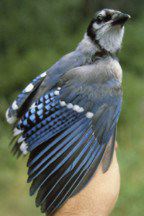 Suddenly, a large blue and white bird screaming "Jay! Jay! Jay!" swoops to my feeder and chickadees, nuthatches, and assorted winter finches scatter in all directions. There's no doubt one of the local Blue Jays has just arrived to gobble down its share of sunflower seed and cracked corn.
Suddenly, a large blue and white bird screaming "Jay! Jay! Jay!" swoops to my feeder and chickadees, nuthatches, and assorted winter finches scatter in all directions. There's no doubt one of the local Blue Jays has just arrived to gobble down its share of sunflower seed and cracked corn.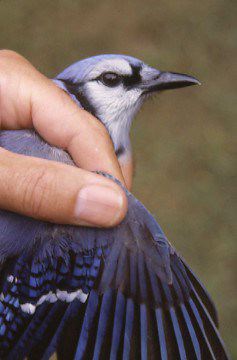 I also spent a lot of time rationalizing a year-round Blue Jay study for Minnesota natives who wondered about my sanity. Many people there--and elsewhere--think of Blue Jays as unwanted "weed birds," and despite their eye-pleasing appearance, jays suffer from generally bad reputations. I guess I can understand how jay critics feel, since I distinctly remember my own attitude during my first winter in Minnesota. Before I saw the need to study them, I expended considerable energy rapping on my living room window, scaring aggressive Blue Jays away from my feeder so smaller birds could get a few sunflower seeds in sub-zero temperatures.
I also spent a lot of time rationalizing a year-round Blue Jay study for Minnesota natives who wondered about my sanity. Many people there--and elsewhere--think of Blue Jays as unwanted "weed birds," and despite their eye-pleasing appearance, jays suffer from generally bad reputations. I guess I can understand how jay critics feel, since I distinctly remember my own attitude during my first winter in Minnesota. Before I saw the need to study them, I expended considerable energy rapping on my living room window, scaring aggressive Blue Jays away from my feeder so smaller birds could get a few sunflower seeds in sub-zero temperatures.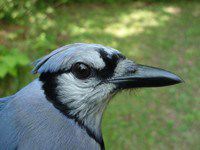 peckers--as I often found out while handling jays for banding.
peckers--as I often found out while handling jays for banding.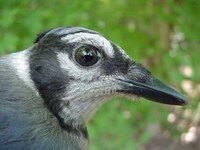 Even in-hand it is impossible for a bander to sex a Blue Jay-except during the breeding season when the female, like most songbirds, develops a naked expanse of belly skin called an "incubation patch" or "brood patch." This area, devoid of feathers and filled with tiny blood vessels, provides a direct source of heat for eggs and, later, for nestlings. The male jay does not have a brood patch, but around the cloacal opening he usually has a swelling, or protuberance, where sperm are temporarily stored. During most of the year, however, there is neither a brood patch or a cloacal protuberance, and since jays look alike to us humans it's usually impossible to tell which parent is incubating eggs, brooding, or feeding the young.
Even in-hand it is impossible for a bander to sex a Blue Jay-except during the breeding season when the female, like most songbirds, develops a naked expanse of belly skin called an "incubation patch" or "brood patch." This area, devoid of feathers and filled with tiny blood vessels, provides a direct source of heat for eggs and, later, for nestlings. The male jay does not have a brood patch, but around the cloacal opening he usually has a swelling, or protuberance, where sperm are temporarily stored. During most of the year, however, there is neither a brood patch or a cloacal protuberance, and since jays look alike to us humans it's usually impossible to tell which parent is incubating eggs, brooding, or feeding the young.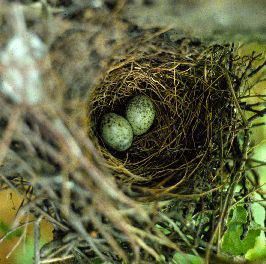 During the time the female sits on the eggs, she may leave for a few minutes each hour to stretch or perhaps grab a quick snack. In most pairs, the male feeds the female on the nest, or he may fly to a nearby perch, meet the female there, and pass her a morsel of food.
During the time the female sits on the eggs, she may leave for a few minutes each hour to stretch or perhaps grab a quick snack. In most pairs, the male feeds the female on the nest, or he may fly to a nearby perch, meet the female there, and pass her a morsel of food.


